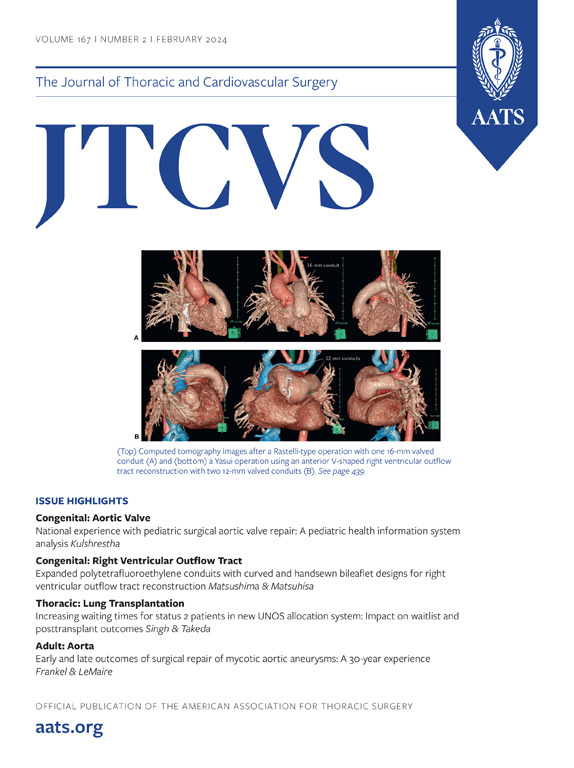无血肺移植:两种中央静脉动脉 ECMO 抗凝策略的比较及其对肺移植结果的影响。
IF 4.9
1区 医学
Q1 CARDIAC & CARDIOVASCULAR SYSTEMS
Journal of Thoracic and Cardiovascular Surgery
Pub Date : 2024-10-10
DOI:10.1016/j.jtcvs.2024.09.055
引用次数: 0
摘要
目的我们报告了 VA-ECMO 术中支持期间两种抗凝方案的差异及其对肺移植术后预后的影响:我们对 2016 年 1 月 1 日至 2023 年 12 月 30 日期间接受术中 VA-ECMO 的双肺移植患者进行了回顾性分析。在此期间实施了两种不同的抗凝方案。其中一个方案包括目标 ACT > 180s,并在拔管后逆转质胺。第二种方案包括在插管时使用 75 Ui 的肝素,在 ECMO 启动后不重新给药并输注 TXA:共有 116 名患者(46 名低肝素患者,70 名标准患者)纳入分析。两组患者的插管策略和 ECMO 循环相同。低肝素方案组的手术时间(7.28 小时对 8.53 小时,P0.99)、肺炎(P=0.38)或急性肾损伤(需要肾脏替代治疗)(P=0.59)更短。移植后72小时出现严重3级PGD的比例没有差异(P=0.42):结论:我们的低肝素VA-ECMO方案用于肺移植术中支持,显著减少了血液制品的使用。结论:我们的低肝素 VA-ECMO 术中支持方案大大减少了血液制品的使用量,虽然这并没有降低 PGD 3 的发生率,但低肝素方案与相似的术后结果相关。本文章由计算机程序翻译,如有差异,请以英文原文为准。
Bloodless lung transplantation: Comparison between 2 central venoarterial extracorporeal membrane oxygenation anticoagulation strategies and their impact on lung transplant outcomes
Objective
To report differences between 2 anticoagulation protocols during venoarterial extracorporeal membrane oxygenation (VA-ECMO) intraoperative support and their effects on outcomes after lung transplantation.
Methods
We performed a retrospective analysis of patients undergoing double-lung transplantation with intraoperative VA-ECMO from January 1, 2016, to December 30, 2023. Two distinct anticoagulation protocols were in place during this period. One included targeted activated clotting time >180 seconds at all times with protamine reversal after decannulation. The second included 75 units per kilogram of heparin at the time of cannulation with no redosing plus a tranexamic acid infusion after ECMO initiation.
Results
A total of 116 patients (46 low heparin, 70 standard) were included in the analysis. Cannulation strategies and ECMO circuit were equivalent between the groups. The low-dose heparin protocol group had a shorter surgical time (7.28 hours vs 8.53 hours, P < .001) and required significantly less intraoperative packed red blood cells (median 0 vs 4.37 units, P < .001), fresh-frozen plasma (median 0 vs 2 units, P < .001), platelets (median 0 vs 1 units, P < .001), cryoprecipitate (median 0 vs 0 units, P < .001), and total blood products (median 0 vs 9 units, P < .001) compared with the standard group. There were no differences in rates of deep vein thrombosis (P = .13), airway dehiscence (P > .99), pneumonia (P = .38), or acute kidney injury requiring renal-replacement therapy (P = .59). There was no difference in rates of severe grade 3 primary graft dysfunction at 72 hours after transplant (P = .42).
Conclusions
Our low-dose heparin VA-ECMO protocol for intraoperative support during lung transplantation led to a significant reduction of blood product use. Although this did not translate to a reduced rates of grade 3 primary graft dysfunction, the low-dose heparin protocol was associated with similar postoperative outcomes.
求助全文
通过发布文献求助,成功后即可免费获取论文全文。
去求助
来源期刊
CiteScore
11.20
自引率
10.00%
发文量
1079
审稿时长
68 days
期刊介绍:
The Journal of Thoracic and Cardiovascular Surgery presents original, peer-reviewed articles on diseases of the heart, great vessels, lungs and thorax with emphasis on surgical interventions. An official publication of The American Association for Thoracic Surgery and The Western Thoracic Surgical Association, the Journal focuses on techniques and developments in acquired cardiac surgery, congenital cardiac repair, thoracic procedures, heart and lung transplantation, mechanical circulatory support and other procedures.

 求助内容:
求助内容: 应助结果提醒方式:
应助结果提醒方式:


